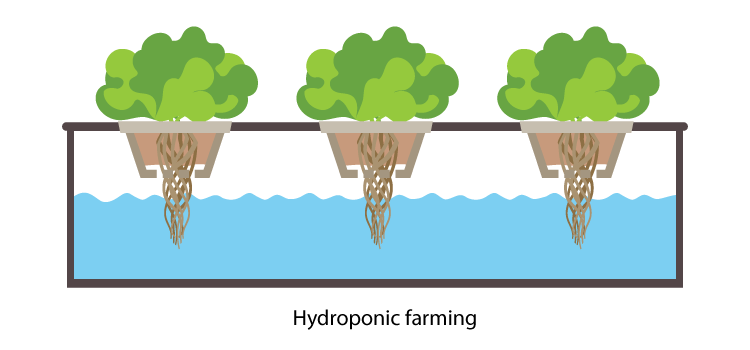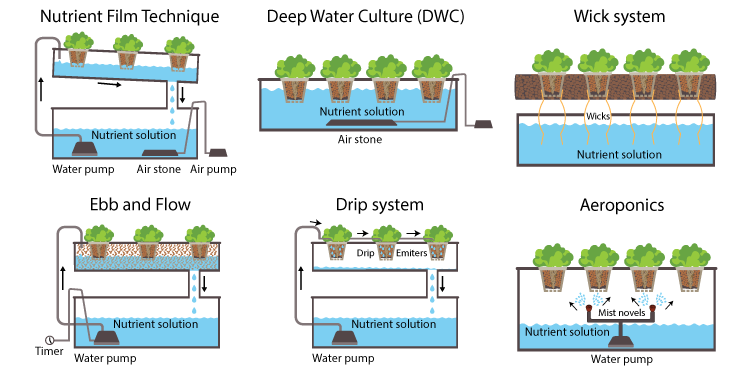Table of Contents
- What is Hydroponics?
- Types of Hydroponic Systems
- Benefits of Hydroponic Farming
- Hydroponic Setup
- Summary
- Frequently Asked Question
Plants transform light energy to chemical energy by the process of Photosynthesis. They need light, water, CO2, and certain minerals. Plants derive water and the nutrients essential for the growth from soil. In 1860, Von Sachs, a German botanist demonstrated that plants can grow without soil if they are provided with a nutrient-rich solution and fulfil their oxygen demand. This technique of growing plants without soil is known as hydroponics, aquaculture or soilless culture/. It may sound weird to grow plants without soil but there are many plants like tomatoes that are already being grown hydroponically.
What is Hydroponics?

The word “Hydroponics” is derived from the word “hydros” meaning water and “ponos” meaning toil or labour. It is an agricultural technique where plants are grown in a nutrient solution in the complete absence of soil. Here, the soil is substituted by sterile mediums such as rockwool, vermiculite, sand, gravel, clay pellets, perlite to give stability to roots. Nutrients are passed through roots differently, based on the type of hydroponic system used, oxygen is pumped through, pH level is regulated and sufficient light is provided to carry out photosynthesis. In the areas where natural light is not available, artificial lighting is provided. It is an innovative method of farming and is being widely used now for food production.
The hydroponic farming technique is used in determining the deficiency symptoms of various nutrients in plants and to find out essential nutrients for the plant’s growth and development.
Examples of plants grown hydroponically include: strawberries, tomatoes and lettuce. It was observed that hydroponic tomato flowers appeared two weeks earlier than the soil grown ones.
Types of Hydroponic Systems

Plants need water, mineral nutrients and oxygen to thrive. There are six hydroponic setups, based on different ways by which these requirements are fulfilled.
- Ebb and Flow System: It requires a medium such as perlite to give stability. Water and mineral solutions are periodically pumped into the tray containing plants. Plants absorb the solution and the remaining solution drains back to the reservoir. This method is simple and used in home gardens. Herbs are grown by this method.
- Nutrient Film Technique (NFT): No medium is required. Hydroponic plants are kept in wooden channels having a slope. The mineral solution is pumped to the high end of the channel and slope down water is collected and reused. Plants with large roots are grown by this method.
- Drip Systems: It is similar to ebb and flow but here water goes through smaller tubes and drain on top of plants. Small plants having less developed root systems are grown using this method.
- Wick Systems: This is a medium based system where perlite or rockwool is used. Nylon rope is placed at the base of each root which extends to the reservoir. It takes up minerals and water and releases it in the medium which makes it available for plants. It is an economical method of hydroponic farming because no pumps are required.
- Aeroponics: This is a water-based system similar to NFT and doesn’t require a medium. The mineral solution is sprayed onto the plants in the form of mist. This is difficult to set up but is beneficial in the large commercial setting.
- Deep Water Culture (DWC): In a container, the plant’s root is suspended in oxygenated water containing minerals. An air pump is used. This is an easy method and requires low maintenance.
Also Check: Agriculture And Organic Farming
Benefits of Hydroponic Farming
The technique of hydroponic farming has been used since ancient times. Hanging Gardens of Babylon is one such example. There are many benefits of growing plants hydroponically.
- Plants grow faster so the yield is high
- Can be grown anywhere, underground, rooftops and greenhouses
- Plants can be grown where traditional farming is not possible
- Water and nutrients are recycled and reused
- Organic food can be produced without using fertilisers or pesticides
- Hydroponics is extensively used in space research programmes. Hydroponics can be used to grow food away from earth where soil is unavailable
In spite of all the benefits, there are a few drawbacks of using hydroponics:
- High upfront investment
- Requires technical knowledge
- It can be misused to grow banned products like marijuana
Hydroponic Setup
A hydroponic setup or a hydroponic plant requires certain components. Let us dive into each of the components separately.
- Reservoir: It is the container that holds the nutrient solution required for the growth of plants. It is usually a plastic or glass container. A metallic container should not be used as it can bring harmful chemicals.
- Grow Tray: A grow tray is essential in a hydroponic setup to hold the plants. It may have valves for better gripping and sometimes also contains mediums such as coco coir, clay and pebbles.
- Growing Medium: A growing medium is the medium on which the plant grows, because there is no soil in a hydroponic setup. It can be vermiculite, coconut fibre, perlite or gravel.
- Nutrient Solution: Nutrient solution is nothing but minerals dissolved in water. A nutrient solution for a hydroponic plant is prepared by dissolving essential minerals in required dosage to feed the plants.
Hydroponic farming can be successful if these components are set up intricately. Other factors such as the hydroponic plant, space requirements, water supply, pipes and economical needs should also be considered.
Summary
Hydroponic Farming is very much in trend these days as it gives us organic produce. It can be really useful in areas that have water scarcity. Additionally, the water can be reused for growing plants. The plants obtained from this technique are high in nutrients and free of any toxins.
This was in brief about the hydroponic system. For more such information related to NEET, visit BYJU’S.
Further reading:
- Nodule Formation
- Flashcards Of Biology For NEET Mineral Nutrition
- What Are The 5 Stages Of The Nitrogen Cycle?
- Is Nitrosomonas a nitrogen-fixing bacteria?
- How Do Bacteria Act As Decomposers In Carbon Cycle?
Frequently Asked Questions
Is hydroponic farming profitable?
Hydroponic farming can prove to be profitable as it produces large amount of crops in a small space.
What is the most profitable hydroponic crop?
Lettuce is the most profitable hydroponic crop as it grows fast and takes less space.
How do you set up a hydroponic plant?
There are ready made hydroponic plants available, otherwise you can install a hydroponic setup by choosing the nutrient medium and growing medium and arranging reservoir, grow trays, pumps and pipes.

Comments